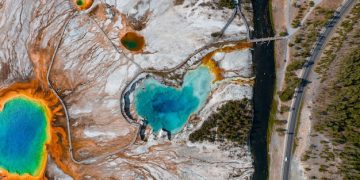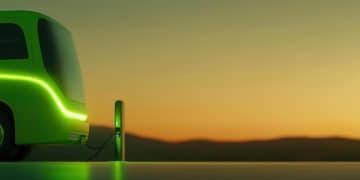Wave Energy: Exploring US Pilot Projects & Future Prospects

Wave energy converters (WECs) represent a promising avenue for renewable energy in the US, with recent pilot projects showcasing the potential of harnessing ocean waves to generate clean electricity and contribute to a sustainable energy future.
The allure of the ocean’s boundless energy has long captivated innovators. Today, **exploring the potential of wave energy converters: recent US pilot projects and future prospects** is more critical than ever as we seek sustainable alternatives to fossil fuels. This article delves into the current status of wave energy technology within the United States, highlighting pioneering projects and forecasting the future of this burgeoning renewable energy source.
Introduction to Wave Energy Converters in the US
Wave energy, an abundant and predictable resource, offers a compelling solution to the growing demand for clean electricity. Within the US, a number of initiatives are underway to harness this untapped potential. These pilot projects not only demonstrate the feasibility of wave energy but also pave the way for larger-scale deployments that could significantly reduce our reliance on traditional energy sources.
The Promise of Wave Energy
Wave energy converters (WECs) come in various forms, each designed to capture the kinetic energy of ocean waves and transform it into electricity. From oscillating water columns to point absorbers, these technologies are at the forefront of innovation in renewable energy. The potential benefits are immense, ranging from reduced carbon emissions to increased energy security.
US Initiatives and Funding
The US Department of Energy (DOE) has been instrumental in supporting wave energy research and development. Through grants, partnerships, and pilot programs, the DOE is fostering a collaborative ecosystem that brings together researchers, engineers, and entrepreneurs. This collective effort is driving innovation and accelerating the deployment of wave energy technologies across the nation.
- DOE Funding Opportunities: Explore the various funding programs available for wave energy projects.
- Research Partnerships: Learn about the collaborations between universities, national labs, and private companies.
- Pilot Programs: Discover the current pilot projects underway and their impacts.
Wave energy converters represent a significant step towards a sustainable energy future in the US. Ongoing research, innovative technologies, and supportive government initiatives are paving the way for its widespread adoption.

Recent US Pilot Projects: Showcasing Innovation
Several pilot projects across the United States are currently testing the viability and efficiency of wave energy converters. These projects not only serve as real-world demonstrations but also provide valuable data and insights that inform future designs and deployments. From the Pacific Northwest to the Atlantic coast, these initiatives are pushing the boundaries of what’s possible.
Oregon State University’s PacWave
PacWave, located off the coast of Oregon, is the nation’s first grid-connected, utility-scale wave energy test site. This facility provides a controlled environment for developers to test their WECs in real-world conditions. The data collected from these tests is crucial for validating designs and optimizing performance.
CalWave Power Technologies
CalWave is pioneering a submerged pressure differential WEC technology that is designed to be both efficient and environmentally friendly. Their pilot project in California is demonstrating the potential of this innovative approach, offering a more streamlined and less visually intrusive solution compared to above-water alternatives.
Current US pilot projects are crucial for refining wave energy technologies and understanding their real-world performance. They provide invaluable data that informs future development efforts and pave the way for broader adoption.
Technological Advancements in Wave Energy Converters
The evolution of wave energy converters has been marked by continuous innovation and improvement. Over the years, engineers and researchers have developed a variety of designs, each with its own unique advantages and challenges. From oscillating water columns to submerged pressure differentials, the field is ripe with technological advancements.
Oscillating Water Columns (OWCs)
Oscillating Water Columns (OWCs) represent a proven technology for capturing wave energy. These devices use the rising and falling motion of waves to compress air, which then drives a turbine to generate electricity. OWCs are relatively simple in design and can be constructed onshore or offshore.
Point Absorbers
Point absorbers are floating devices that rise and fall with the waves, using this motion to drive a generator. They can be deployed individually or in arrays and are particularly suitable for deep-water locations. Recent advancements in materials and control systems have significantly improved their efficiency.
- Advanced Materials: Development of stronger, lighter, and more corrosion-resistant materials.
- Control Systems: Sophisticated algorithms that optimize performance based on wave conditions.
- Grid Integration: Improved methods for integrating wave energy into existing power grids.
Technological advancements in wave energy converters are continually improving their efficiency, reliability, and cost-effectiveness. These innovations are essential for making wave energy a competitive and sustainable alternative to traditional energy sources.
Environmental Considerations and Sustainability
While wave energy offers a clean and renewable alternative to fossil fuels, it is essential to consider its potential environmental impacts. Careful planning, responsible deployment, and ongoing monitoring are crucial for ensuring the sustainability of wave energy projects. Addressing environmental concerns is paramount for responsible implementation.
Impact on Marine Life
One of the primary concerns is the potential impact on marine ecosystems. WECs can create underwater noise, alter wave patterns, and affect the habitat of marine species. Mitigation strategies include careful site selection, noise reduction technologies, and monitoring programs to assess and minimize potential harm.
Visual Impact and Aesthetics
The visual impact of WECs, particularly those located near shore, can be a concern for coastal communities. Submerged or low-profile designs can help minimize this impact. Public engagement and transparent communication are essential for addressing aesthetic concerns and gaining community support.
Environmental stewardship is essential for the sustainable development of wave energy in the US. By addressing potential impacts and implementing mitigation strategies, we can harness the power of the ocean while protecting marine ecosystems.

Economic Viability and Market Potential
The economic viability of wave energy hinges on reducing costs, improving efficiency, and attracting investment. As technology advances and deployment experience grows, wave energy is poised to become increasingly competitive with other renewable energy sources. Realizing its market potential requires strategic planning and investment.
Cost Reduction Strategies
Reducing the cost of WECs is a key priority. Strategies include streamlining manufacturing processes, improving component durability, and optimizing designs for mass production. Economies of scale can play a significant role in lowering the overall cost of wave energy.
Government Incentives and Policies
Supportive government policies and incentives can accelerate the adoption of wave energy. Tax credits, grants, and feed-in tariffs can make wave energy projects more financially attractive to investors. Clear regulatory frameworks and streamlined permitting processes are also essential.
- Investment Opportunities: Explore the growing interest in wave energy from venture capitalists and private investors.
- Job Creation: Identify the potential for wave energy to create new jobs in manufacturing, installation, and maintenance.
- Energy Security: Understand how wave energy can contribute to greater energy independence and resilience.
Wave energy holds significant economic potential for the US, offering opportunities for job creation, energy security, and sustainable economic growth. Overcoming cost barriers and fostering a supportive policy environment are essential for realizing this potential.
Future Prospects: Wave Energy in the US Energy Mix
Looking ahead, wave energy is poised to play an increasingly important role in the US energy mix. With continued innovation, supportive policies, and growing public awareness, wave energy can help diversify our energy sources, reduce carbon emissions, and create a more sustainable future. It is a promising avenue for energy diversification and sustainability.
Long-Term Vision
The long-term vision for wave energy includes large-scale deployments that can power coastal communities and contribute to the national grid. This vision requires ongoing research, development, and demonstration to validate performance and reduce costs. Collaboration between government, industry, and academia is essential for achieving this goal.
Policy Recommendations
To support the growth of wave energy, policymakers can implement several key measures. These include providing long-term funding for research and development, establishing clear regulatory frameworks, and offering financial incentives for wave energy projects. Public-private partnerships can also play a crucial role in accelerating deployment.
| Key Point | Brief Description |
|---|---|
| 🌊 Wave Energy Potential | Vast untapped resource for clean electricity. |
| 💰 Economic Benefits | Job creation and energy security. |
| 🌎 Environmental Impact | Requires careful planning to minimize harm. |
| 🚀 Technological Advances | Continuous innovation improving efficiency. |
Now, let’s address some Frequently Asked Questions:
[FAQ]What is a Wave Energy Converter?
▼
A wave energy converter (WEC) is a device that transforms the kinetic energy of ocean waves into electricity, providing a clean and renewable energy source.
▼
Key locations include the PacWave test site in Oregon and pilot projects in California, demonstrating varied technological approaches to wave energy harvesting.
▼
Potential issues include disturbance to marine life, alteration of wave patterns, and visual impacts, all requiring careful mitigation and monitoring.
▼
Cost reduction can be achieved through technological advancements, economies of scale in manufacturing, and supportive government policies and incentives.
▼
The future is promising, with wave energy playing a larger role in the energy mix, driven by innovation, policy support, and growing public awareness.
Conclusion
As the United States continues to prioritize renewable energy sources, **exploring the potential of wave energy converters: recent US pilot projects and future prospects** remains crucial. These endeavors not only unlock a sustainable energy source but also drive economic growth and innovation, shaping a cleaner, more resilient future for generations to come.





